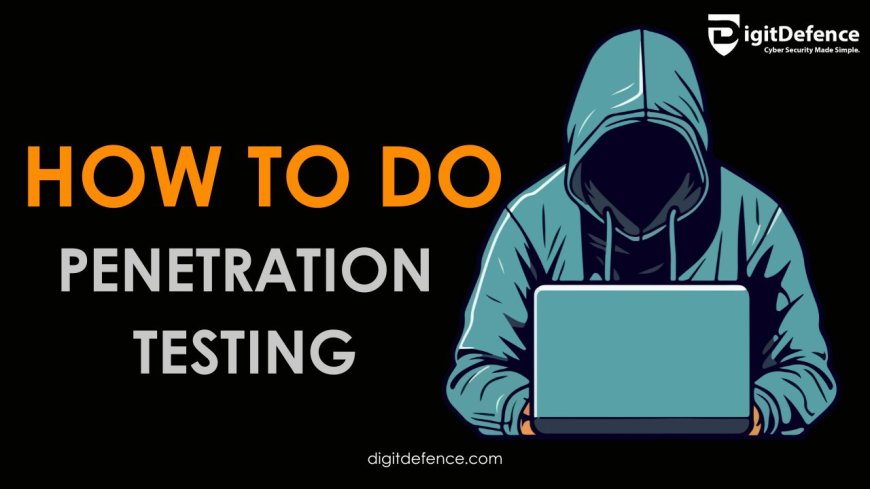How to do penetration testing
Learn effective penetration testing techniques to secure your systems. Discover tools, methods, and best practices for thorough cybersecurity assessments.

One of the main components of cybersecurity is penetration testing, which simulates actual cyber threats by carefully evaluating system or network security. Testers use a combination of automated technologies and manual procedures to gather information, find weaknesses, and attempt exploitation. They start with careful planning and scoping. Successful assaults are evaluated by post-exploitation analysis, and defenses are improved through repair suggestions. By incorporating lessons learned, continuous improvement guarantees strong defense against new attacks and increases overall cybersecurity resilience. Post-exploitation evaluation, increasing privileges, exploit frameworks, and vulnerability study are important ideas.
Consider yourself a cybersecurity expert assigned to carry out penetration testing for a global company moving to cloud-based infrastructure. You evaluate endpoint security and cloud safety risks throughout the organization's digital environment, starting with careful planning and scoping. You do vulnerability checks to find potential hazards and use exploit frameworks to mimic actual cyber threats by combining automated tools and manual procedures. Post-exploitation analysis assesses the consequences of successful attacks and offers information for further risk assessment and remediation initiatives. The inclusion of cloud security, endpoint security, and risk assessment into the penetration testing procedure guarantees an all-encompassing defense against new threats and improves the cybersecurity resilience of the organization.
Complications in penetration testing
-
Limited Access and Permissions: Obtaining access and permissions to conduct penetration testing can be challenging, especially in highly regulated environments or with third-party systems. Without proper authorization, testers may face legal or ethical issues.
-
Complexity of Systems: Modern IT environments are often complex, with numerous interconnected systems, applications, and networks. Testing all components comprehensively can be difficult, leading to oversight of potential vulnerabilities.
-
False Positives and False Negatives: Automated scanning tools used in penetration testing may generate false positives (indicating vulnerabilities that don't exist) or false negatives (failing to detect actual vulnerabilities). Distinguishing between legitimate security risks and false alarms requires careful analysis.
-
Impact on Production Systems: Penetration testing involves actively probing and exploiting vulnerabilities, which can disrupt or impact production systems if not conducted carefully. Testers must minimize the risk of unintended consequences or system downtime during testing.
-
Detection and Response: Organizations with mature security operations may detect and respond to penetration testing activities, inadvertently triggering security alerts or causing unnecessary alarms. Coordinating with internal security teams to avoid confusion is essential.
-
Third-Party Dependencies: Testing systems or applications hosted by third-party vendors or service providers may require coordination and cooperation, which can introduce logistical challenges and delays in scheduling.
-
Regulatory Compliance: Penetration testing may be subject to regulatory requirements or industry standards, such as PCI DSS or GDPR. Ensuring compliance with relevant regulations while conducting testing can add complexity and administrative overhead.
-
Resource Constraints: Limited time, budget, and resources can constrain the scope and depth of penetration testing activities, making it challenging to achieve comprehensive coverage or adequately address identified vulnerabilities.
What Are the Key Components of a Penetration Testing Process
-
Planning and Scoping: Define what we want to test and why. Get permission to test and make sure it's legal and ethical.
-
Information Gathering: Collect basic details about the system we're testing. Look around online to find out more about it.
-
Vulnerability Analysis: Use tools to find weaknesses in the system's security. Look for things like weak passwords or software bugs.
-
Exploitation: Try to break into the system using the weaknesses we found. See if we can access sensitive information or control the system.
-
Post-Exploitation Assessment: Check how much damage we could do if we were a real attacker. Write down what we found and suggest ways to fix it.
-
Reporting and Remediation: Make a report of what we found and share it with the people responsible for the system's security. Work with them to fix the problems we found and make the system safer.
How to do penetration testing
-
Define Objectives: Determine the goals and objectives of the penetration test. Decide what you want to achieve, whether it's identifying vulnerabilities, testing security controls, or assessing specific scenarios.
-
Plan and Scope: Clearly define the scope of the penetration test, including the systems, applications, and networks to be tested. Obtain necessary permissions and approvals from stakeholders to conduct the test.
-
Gather Information: Collect information about the target environment to understand its architecture and potential vulnerabilities. Use techniques like reconnaissance, network scanning, and open-source intelligence gathering.
-
Vulnerability Analysis: Identify vulnerabilities in the target systems and applications using automated scanning tools and manual techniques. Look for weaknesses such as outdated software, misconfigurations, and weak passwords.
-
Exploitation: Attempt to exploit identified vulnerabilities to gain unauthorized access or compromise the target systems. Use penetration testing tools and techniques to simulate real-world attack scenarios.
-
Post-Exploitation Assessment: Assess the impact of successful exploits on the target environment. Document findings and recommendations for remediation, including prioritizing critical vulnerabilities and mitigating controls.
-
Reporting and Remediation: Compile a comprehensive report of the penetration test findings, including executive summaries, technical details, and actionable recommendations. Work with stakeholders to address identified vulnerabilities and implement remediation measures.
-
Continuous Improvement: Learn from the results of the penetration test and incorporate lessons learned into future security measures. Regularly review and update security controls to mitigate emerging threats and vulnerabilities.
Penetration testing is a key component of cybersecurity because it enables companies to proactively find and fix security flaws before bad actors can take advantage of them. Through meticulous planning and scoping of the test, comprehensive risk analysis, and information collection about the target environment, testers can imitate real-world cyber threats and evaluate the efficacy of current security solutions. Continuous improvement makes sure that businesses remain ahead of ever-evolving cyber threats, while post-exploitation assessment and reporting offer insightful information for repair efforts.































